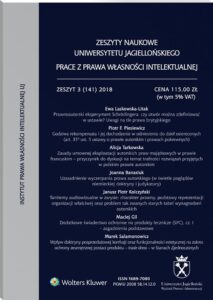WERSJA POLSKA
Charakter prawny tantiem audiowizualnych
Polski ustawodawca wprowadził w art. 70 ust. 21 ustawy o prawie autorskim i prawach pokrewnych odrębne od majątkowych praw autorskich prawo podmiotowe (do niezrzekalnego wynagrodzenia) z jego własnym zakresem ochrony, zakresem podmiotowym i przedmiotowym, którego samodzielne ustalanie przez organizację zbiorowego zarządzania prawami autorskimi i pokrewnymi, poza sytuacją skorzystania z zatwierdzonej tabeli wynagrodzeń autorskich, jest zasadniczo niedozwolone. Autorowi niniejszego opracowania bliżej do koncepcji względnego podmiotowego prawa do wynagrodzenia, niż do postrzegania go jako element treści bezwzględnego majątkowego prawa autorskiego. Chodziłoby o prawo samoistne, normę prawną modyfikującą stosunki umowne zawierane przez producenta (lub samych uprawnionych) z korzystającymi z dzieł audiowizualnych na korzyść współtwórców utworów audiowizualnych lub artystów wykonawców. W tym sensie można mówić o rozszerzonym skutku prawa do tantiem.
Pośrednictwo organizacji zbiorowego zarządzania w poborze tantiem audiowizualnych
 Autor twierdzi, że ponieważ ustawa nazywa tantiemy „wynagrodzeniem stosownym”, kieruje to uwagę na wynagrodzenie wynikające z umowy i relację uprawniony–korzystający z pośrednikiem „w tle”, choć działającym jako strona umowy. Według jego opinii bardziej przekonujący wydaje się więc argument upatrujący w tej relacji instytucji zastępstwa pośredniego, co zakłada istnienie stosunku podstawowego między OZZ a uprawnionym, na którego rzecz ta pierwsza ma działać występując jednak wobec korzystających we własnym imieniu; skoro korzystający (dłużnik) ma (obowiązkowo) za jej pośrednictwem wypłacać uprawnionemu (wierzycielowi) tantiemy. Autor twierdzi również, że organizacja zbiorowego zarządzania nie może – co do zasady – ustalać wysokości tantiem audiowizualnych w oderwaniu od powierzenia praw w zbiorowy zarząd. Wysokość ta może jednak wynikać z decyzji władczej KPA zatwierdzającej tabelę wynagrodzeń autorskich.
Autor twierdzi, że ponieważ ustawa nazywa tantiemy „wynagrodzeniem stosownym”, kieruje to uwagę na wynagrodzenie wynikające z umowy i relację uprawniony–korzystający z pośrednikiem „w tle”, choć działającym jako strona umowy. Według jego opinii bardziej przekonujący wydaje się więc argument upatrujący w tej relacji instytucji zastępstwa pośredniego, co zakłada istnienie stosunku podstawowego między OZZ a uprawnionym, na którego rzecz ta pierwsza ma działać występując jednak wobec korzystających we własnym imieniu; skoro korzystający (dłużnik) ma (obowiązkowo) za jej pośrednictwem wypłacać uprawnionemu (wierzycielowi) tantiemy. Autor twierdzi również, że organizacja zbiorowego zarządzania nie może – co do zasady – ustalać wysokości tantiem audiowizualnych w oderwaniu od powierzenia praw w zbiorowy zarząd. Wysokość ta może jednak wynikać z decyzji władczej KPA zatwierdzającej tabelę wynagrodzeń autorskich.
Problem tzw. starych tabel wynagrodzeń autorskich
Wreszcie autor uważa, że przy założeniu racjonalnego działania ustawodawcy oraz uwzględniając wykładnię przepisów dokonaną przez Trybunał Konstytucyjny można przyjąć, że tzw. dawne tabele wynagrodzeń autorskich zatwierdzane na podstawie uchylonych przez Trybunał przepisów, przywrócono w 2010 r. ze skutkiem na przyszłość (ex nunc), co uzależniono od działania samej OZZ, o czym może świadczyć specyficzna procedura definitywnej utraty wspomnianej mocy wiążącej przez dawne tabele.
Pełna wersja artykułu będzie dostępna tu.
ENGLISH VERSION*
Legal nature of audiovisual royalties
The Polish law introduced, in Art. 70.2(1) of the Act on Copyright and Related Rights, in addition to author’s economic rights, a separate legal right (to remuneration, which cannot be waived) with its particular type of protection, group of rightholders and scope, which in principle cannot be determined by an organisation for collective management of copyright and related rights (CMO), with the exception of using an approved royalty table. The author of this article tends to share the view about an inter-partes character of the right to the remuneration in question, rather than perceiving it as an element of an absolute author’s economic right. It would be an independent right, a legal norm that modifies the contractual relationship between the producer (or the rightholders themselves) and the users of audiovisual works for the benefit of the joint authors of audiovisual works or artistic performers. In this sense one can speak of an extended effect of the right to royalties.
The mediation of CMO in collecting the audiovisual royalties
The author believes that since the statute refers to royalties as ‘equitable remuneration’, this draws attention to the contractual remuneration and the relationship between the righholder and the user, with the intermediary ‘in the background’, though acting as a party to the contract. In the author’s view, there more convincing arguments in support of the thesis that this relationship is one of indirect agency, which assumes the existence of a basic relationship between the collective management organisation and the rightholder in whose interest the CMO is to act, yet acting in its own name vis-à-vis the users, once the user (debtor) is required (mandatorily) to pay royalties to the rightholder (creditor) via the CMO. The author also believes that a CMO cannot, as a rule, determine the amounts of audiovisual royalties in abstract from it being entrusted with the rights under collective management. Yet this amount can result from an authoritative decision of the Copyright Commission approving a royalty table.
The problem of the so-called old remuneration tables
Finally, the author believes that – with the assumption of a rational legislator and considering the interpretation of provisions made by the Constitutional Tribunal – it can be accepted that the so-called old royalty tables approved on the basis of provisions repealed by the Constitutional Tribunal were reinstated in 2010 with effect for the future (ex-nunc), which effect was made conditional upon the operation of a CMO, as can be demonstrated by the specific procedure of definitive loss of the aforementioned binding force by the old tables.
Full version of the article will be available here
* tłumaczenie w większości pochodzi od redakcji.









